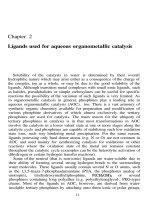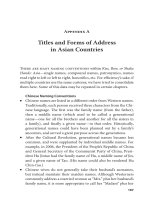Tài liệu Chapter 8: Catalytic oxidations in aqueous media - recent developments ppt
Bạn đang xem bản rút gọn của tài liệu. Xem và tải ngay bản đầy đủ của tài liệu tại đây (186.15 KB, 7 trang )
Chapter 8
Catalytic oxidations in aqueous media - recent
developments
Catalytic oxidation of organic compounds is an extremely important field
of chemistry, spanning the range from biological oxidations to large scale
industrial production of commodity chemicals. However, many of these
transformations can hardly be classified as organometallic reactions, since
the catalysts (often simple metal salts) and the intermediates can be rather
regarded as coordination complexes than organometallic compounds.
Therefore our discussion will be limited to a few specific examples, despite
the fact that oxidations have an inherent connection to aqueous systems -
after all in many cases (except e.g. epoxidations or hydrogen transfer
oxidations) water is produced as byproduct. Even the truly organometallic
activation of hydrocarbons by platinum complexes is excluded from this
discussion, the simple reason being in that a monumental treatise [1] of this
fundamentally important problem has appeared quite recently. Other books
and reviews describe the field from the aspects of industry [2,3], basic
catalysis research [4,5,6], activation of dioxygen [7] or hydrogen peroxide
[8] and from that of organic synthesis [9] - and the list is far from being
complete.
8.1 Wacker-type oxidations
This is a genuine organometallic reaction in which ethene is oxidized by
Pd(II) to yield acetaldehyde (eq. 8.1) [3]:
Similar oxidations of longer chain olefins provide methyl ketones,
however, the reaction is accompanied by olefin isomerization and
257
258
Chapter 8
subsequent oxidation so usually a rather complex product mixture is formed.
is prone to aggregate into palladium black, however, this can be
prevented by reoxidation by (eq. 8.2) followed by aerobic oxidation
of to in an excess of HC1 (eq. 8.3). With ethene as
substrate the overall process is described by eq. 8.4.
The reaction has been developed into an industrial process which has
been in production for about 40 years now. Although eq. 8.4 does not tell
about it, the process suffers from the need of a highly corrosive reaction
mixture containing large amounts of copper chlorides - a rather nasty
situation from environmental aspects.
In a quest for a more environment-friendly process it has been found that
reaction 8.4 can be catalyzed by Pd(II) complexes of various nitrogen-donor
ligands (Scheme 8.1) under not too harsh conditions (100 °C, air) without
the need of copper chlorides [10, 11]. Of the investigated ligands, sulfonated
batophenanthroline proved to be the best. Higher olefins, such as 1-hexene
or cyclooctene were similarly transformed by this catalyst. Very
importantly, there was no isomerization to internal olefins and 2-hexanone
was formed with higher than 99 % selectivity. This outstanding selectivity is
probably due to the absence of acid and Cu-chlorides.
In contrast to the usual Wacker-conditions, optimum rates and catalyst
stability in the Pd/batophenanthroline-catalyzed olefin oxidations was
observed in the presence of Under such conditions, the
catalyst-containing aqueous phase could be recycled with about 2-3 % loss
of activity in each cycle. In the absence of NaOAc precipitation of Pd-black
was observed after the second and third cycles. Nevertheless, kinetic data
refer to the role of a hidroxo-bridged dimer (Scheme 8.1) rather than the so-
called giant palladium clusters which could easily aggregate to metallic
palladium.
Poly(ethylene oxide) polymers and poly(ethylene oxide/propylene oxide)
copolymers with iminodipropionitrile (139) or iminodiacetonitrile end
groups were used as ligands in the palladium-catalyzed oxidation of higher
olefins (1-octene to 1-hexadecene) at 50-70 °C with atmospheric air or 1-3
bar In an ethanol/water mixture 88 % yield of 2-hexanone and 92 %
yield of 2-hexadecanone was obtained in 4 and 2 h, respectively, with a
Catalytic oxidations in aqueous media - recent developments
259
substrate/catalyst ratio of 65. The aqueous-alcoholic catalyst solutions could
be recycled with no loss of activity after phase separation [12].
It is known of the Wacker reaction, that at low chloride concentration
(< 1 M) it yields exclusively acetaldehyde. However, at
chloroethanol is produced in appreciable quantities. In a detailed kinetic
study it was established, that when a chloride ligand in is replaced
by pyridine, the intermediate hydroxyethylpalladium complex is stable
enough to undergo reaction with with the formation of
chloroethanol up to a yield of 98 % in 8 M chloride solutions (Scheme 8.2)
[13].
With olefins other than ethene two isomeric chlorohydrins can be
obtained, one of them being chiral. When pyridine was replaced by
monodentate chiral amines in the enantioselectivities
were low (8-12%) (Scheme 8.3) [14]. The mononuclear
complexes performed better providing the
chiral chlorohydrin in 46-76% e.e. Even better activities and
260
Chapter 8
enantioselectivities were achived with the dinuclear, mixed
(bisphosphine or diamine) catalysts (Scheme 8.3) which
allowed enantioselective production of chlorohydrins with several olefins.
The highest optical purities were 94% e.e. for propene and 93 % e.e. for
allylphenyl ether [15]. The reactions can be conducted under mild
conditions, although the environmental concerns with regard to the use of
concentrated solutions still prevail.
8.2 Oxidations with and
An important trend in oxidations is the use of or in place of
inorganic or organic oxidants, allowing the development of green processes
with no toxic by-products or wastes. In the special case of alcohols one
preferred oxidant is chromium(VI) causing obvious problems. An other
method consists of running the oxidations in the presence of reactive
aldehydes, for example butyraldehyde (usually in the presence of a metal-
containing catalyst). In fact, the immediate oxidants for alcohols are the
peracids which form in situ from the aldehydes and (Mukaiyama
oxidations, see e.g. [17]). This reaction, however, also yields one mol of an
acid byproduct for each mol of the target compound. An attractive way for
such reactions would be the use of or as oxidants in a biphasic
Catalytic oxidations in aqueous media - recent developments
261
catalytic process, preferably with water as one of the phases, for easy
product isolation and catalyst recovery.
In the presence of a catalyst N-methylmorpholine-N-
oxide (MMO) reacts with alcohols in dichloroethane or 1,2-dichloroethylene
to afford mostly aldehydes together with carboxylic acids. Instead of the
rather expensive MMO as reagent, a combination of N-methylmorpholine
and aqueous (35 w%) could be used with similar results for the
oxidation of long chain alcohols (1-octanol to 1-hexadecanol) [16]. At the
end of the reaction the aqueous phase, containing the ruthenium catalyst and
methylmorpholine could be recycled with no apparent loss of activity.
Perhaps the most important recent discovery in catalytic oxidation of
alcohols is the use of a catalyst prepared from and sulfonated
batophenanthroline (see Scheme 8.1 above). This catalyst was found to
oxidize primary and secondary, as well as benzylic and allylic alcohols with
close to quantitative yields and 90-100 % selectivities to the corresponding
aldehydes or ketones (Scheme 8.4) [18]. The easy oxidation of non-activated
secondary alcohols is particularly noteworthy since in general these are
rather unreactive towards









